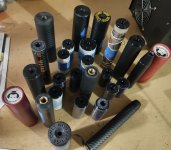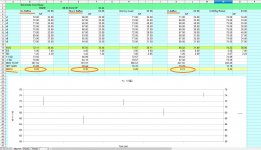I have been making my own moderators/silencers for 40 years. I have done that because of all the restrictions and taboos associated to them. It has only been a recent thing that moderators have been commercially available to the general airgun community. Still, there are restrictions in shipping and restrictions in some locations. So my advice to anyone wanting to do this is keep your mouth shut!
Having said that, I've tried many different designs and some work better than others. Some only work well for a short time. Others are too heavy or suffer size issues. I will list what does not work well then describe my current design. I know these things from first hand personal experience building them
2) Internal expansion chambers stuffed with sound absorbing material works for a short while, then it degrades.
3) Bleed holes drilled in either the end cap or OD tube do not work.
4) Continuous tubular baffle designs often cut with CNC equipment do nothing.(Refer to rule (1))
5) Tight pellet to bore clearance adds little to no performance value.
Some designs baffles work very well, others not so much. My current design uses an inverted cone baffle installed pointed toward the breech. I use 3 baffles with an internal length of 7 inches where the fist baffle is 3 inches from the muzzle. The other baffles are equally spaced at 2 inches each. I use the standard Donnyfl shroud 1/2-20 adapter. It has a .375" bore. The larger the bore the better the shroud volume adds to the first expansion chamber (very important). The baffles fit closely to the ID of the 48 mm aluminum outer tube. The construction is based on 3 all thread stainless steel draw rods compressing the end caps and outer tube together. They also locate the inverted cone baffles incorporating aluminum tubes stacked over the draw rods and through drilled baffles. I use a stack of Belleville washer springs which tension the baffle stack to the end caps. Please note the 3 stainless steel Acorn nuts tensioning the end caps and outer tube together. The all thread rods screw into tapped holes in the rear cap they then protrude through the through drilled front cap. The internal bore to pellet clearance is .5 mm/ .020".
This moderator is mounted to a .25 cal FX Crown. This moderator does attenuate the muzzle velocity by 40 ft/sec. This occurs because the column of air in front of the pellet is also attenuated as well as the propelling air charge behind the pellet slightly reducing the differential pressure across the pellet.
One final note: The inverted cone baffle really helps along with the free space between the caps and baffles. As the pellet exits the muzzle, the pressurized propelling air charge attempts to pass the pellet with an expanding cone of turbulent air. This air then collides with the baffle deflecting the air away from the pellet path pressurizing each chamber progressively though the moderator reducing pressure, air velocity and sound very effectively. My edit is to add that the overall weight is 356 grams. The finish is done by hard anodizing, like a camera body. I feel I can save about 100 grams of weight using lighter draw rods and CF body and end caps, my next project. I also made a ground rod the exact size of the barrel choke diameter as an alignment gauge after installation to verify equal spacing around the pellet path to the front end cap. (Clipping Insurance)



Having said that, I've tried many different designs and some work better than others. Some only work well for a short time. Others are too heavy or suffer size issues. I will list what does not work well then describe my current design. I know these things from first hand personal experience building them
Bad
1) Drilled or slotted tube construction tying both end caps together does not work.2) Internal expansion chambers stuffed with sound absorbing material works for a short while, then it degrades.
3) Bleed holes drilled in either the end cap or OD tube do not work.
4) Continuous tubular baffle designs often cut with CNC equipment do nothing.(Refer to rule (1))
5) Tight pellet to bore clearance adds little to no performance value.
Some designs baffles work very well, others not so much. My current design uses an inverted cone baffle installed pointed toward the breech. I use 3 baffles with an internal length of 7 inches where the fist baffle is 3 inches from the muzzle. The other baffles are equally spaced at 2 inches each. I use the standard Donnyfl shroud 1/2-20 adapter. It has a .375" bore. The larger the bore the better the shroud volume adds to the first expansion chamber (very important). The baffles fit closely to the ID of the 48 mm aluminum outer tube. The construction is based on 3 all thread stainless steel draw rods compressing the end caps and outer tube together. They also locate the inverted cone baffles incorporating aluminum tubes stacked over the draw rods and through drilled baffles. I use a stack of Belleville washer springs which tension the baffle stack to the end caps. Please note the 3 stainless steel Acorn nuts tensioning the end caps and outer tube together. The all thread rods screw into tapped holes in the rear cap they then protrude through the through drilled front cap. The internal bore to pellet clearance is .5 mm/ .020".
This moderator is mounted to a .25 cal FX Crown. This moderator does attenuate the muzzle velocity by 40 ft/sec. This occurs because the column of air in front of the pellet is also attenuated as well as the propelling air charge behind the pellet slightly reducing the differential pressure across the pellet.
One final note: The inverted cone baffle really helps along with the free space between the caps and baffles. As the pellet exits the muzzle, the pressurized propelling air charge attempts to pass the pellet with an expanding cone of turbulent air. This air then collides with the baffle deflecting the air away from the pellet path pressurizing each chamber progressively though the moderator reducing pressure, air velocity and sound very effectively. My edit is to add that the overall weight is 356 grams. The finish is done by hard anodizing, like a camera body. I feel I can save about 100 grams of weight using lighter draw rods and CF body and end caps, my next project. I also made a ground rod the exact size of the barrel choke diameter as an alignment gauge after installation to verify equal spacing around the pellet path to the front end cap. (Clipping Insurance)
Last edited:
Upvote 0

